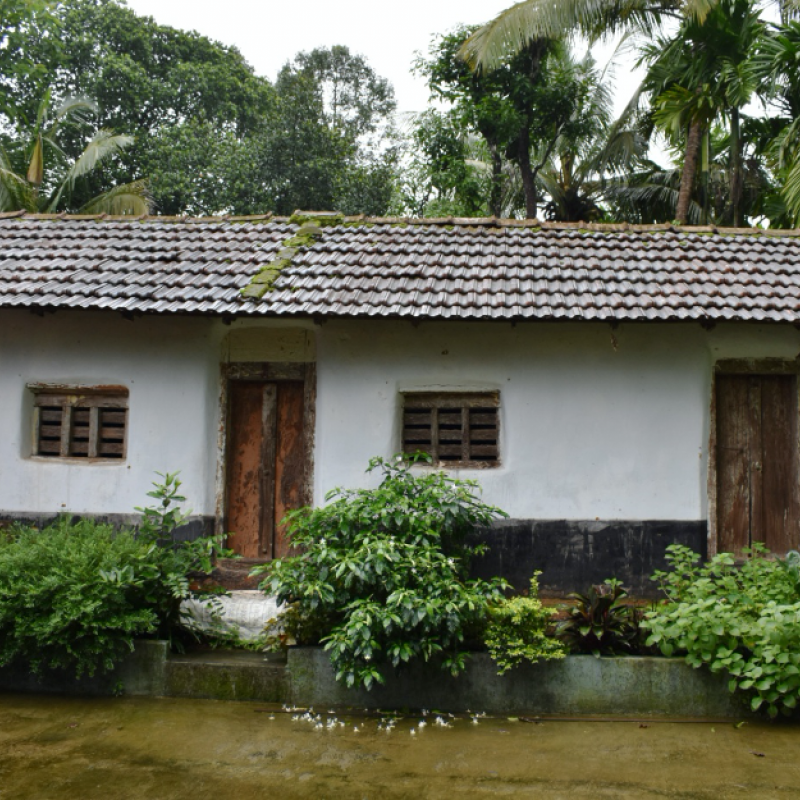Tulunadu, the Tulu-speaking region geographically marked as coastal Karnataka, close to the Western Ghats of India, has several cultural practices dating back to the fifth century. Among these practices, bhoota kola (spirit worship) or bhootaradhane is the perhaps the most well known. It is annually performed till date in every Tulu village.
Like all cultural practices of Tulunadu, bhoota kola, too, has its roots in the guttumanes (guttu homes), which used to be the administrative unit of Tulunadu in the pre-colonial times. Today, these establishments do not hold any administrative importance, but their cultural significance, expressed through events such as bhoota kola, provide scope for studying and understanding Tulunadu’s traditional sociocultural institutions. The administrative power exercised by the guttu owners in the past was prominently derived from the religious importance that they held in association to bhoota kola. Other power-endowing factors included agricultural expertise, land ownership, validation from the village royalty and the infrastructural monopoly in the village which allowed these house owners to provide for the material needs of the village. While all other factors have been nullified with the advent of democracy, the power vested by bhoota kola on guttumanes is still relevant.
The Concept of Bhoota Kola
Bhoota kola is based on a simple belief that several bhootas or daivas (guardian spirits) protect the villages in Tulunadu. Historically, Tuluvas did not believe in God, they only believed in bhootas. Tulavas believe that these bhootas once walked the land as humans, and everyone joins them after death. There are many bhootas, such as Kodamanithaya, Kukkinathaya, Baiderlu, Jumadi, Panjurli, Varthe, Annappa, Kalluraya, Mammayi, Mayindale, each with a story behind their conceptualisation and a designated position in the bhoota hierarchy.
These bhootas are invoked and personified by a paatri (an individual from the Nalike community who impersonates the bhoota at bhootaradhane) during the annual festival of bhootaradhane. The paatri—or multiple paatris, depending on the number of spirits invoked—is dressed in a colourful attire, and his facial features are enhanced with thick paint during the ceremony; he performs a set of initiation rituals to become the bhoota of the village, and later speaks to the villagers assuring their satisfaction over the bhoota kola they organised and took part in. (Fig. 1)
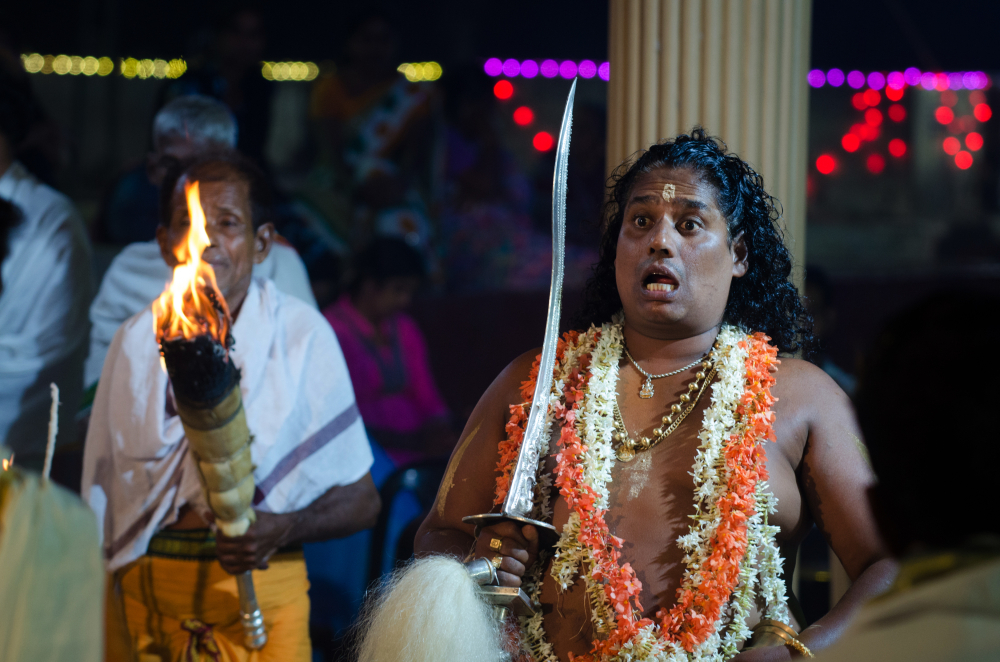
Guttumanes, Bhoota Kola and Administration
The owner of a guttumane always stands, literally, at the forefront during bhootaradhane. In the past, the guttu owner was recognised as the representative of the guardian spirit, which addressed him and vested upon him the power to rule and protect the village on its behalf. Just after the spirit was invoked by the paatri, he would go around dancing vigorously, delivering respects to the rest of the guardian spirits of the village and then halting in front of the guttu owner; the guttu owner would be the first human being to whom the spirit paid its respects. Depending on the spirit impersonated, the paatri would bow his head, lower his sword or torch in front of the guttu owner, and speak a few words to him.
Part of the bhoota kola, dharma nema (roughly translated to justice ritual) took place exclusively to bestow powers to the owner of a guttu. The eldest member of the guttumane, aged above 50, was designated as the pattadhikaari (holder of the throne) during the dharma nema. The spirit designated the guttu owner as its representative and gave him the power to rule the village in a ritual known as gadipradhana. After the gadipradhana, the guttu owner was no longer recognised by his former name, which changed to constitute the name of the position he held, such as Arale, Balipa, Chowta, Poovani, etc., which were surnames indicating different positions of power in the guttu hierarchy. After the gadipradhana, the guttu owner practised extreme self-restraint like celibacy, vegetarianism, strict and short sleeping schedules, and purity rituals. He exercised power and responsibility over the entire village. The religious importance of his position enabled him to effectively carry out his duties without opposition of any kind.
Gadipradhana as well as the custom of the paatri paying respect to the guttu owner takes place even today in some places within the guttumanes of the Jain community, but the designated owner holds only religious importance and does not assume an administrative role.
Tangible Connections
The practice of bhoota kola influenced more than just the administrative powers of guttumanes. Architecturally, guttumanes incorporated bhoota kola by constructing separate rooms to place valuable materials relevant to the cultural practice. The daivakone (room of the guardian spirit) which are constructed in guttumanes accommodated masks, swords, shields, bells, crowns, palanquins and statues—made from bronze, silver, and, sometimes, gold—all of which are significant for bhootaradhane. (Figs 2 and 3) The daivakone is still an important part of the architecture of the guttumane and is not altered without the supervision of religious experts. These rooms are either constructed just outside the house or in the chaavadi (hall of the house), and women are not allowed to enter them.
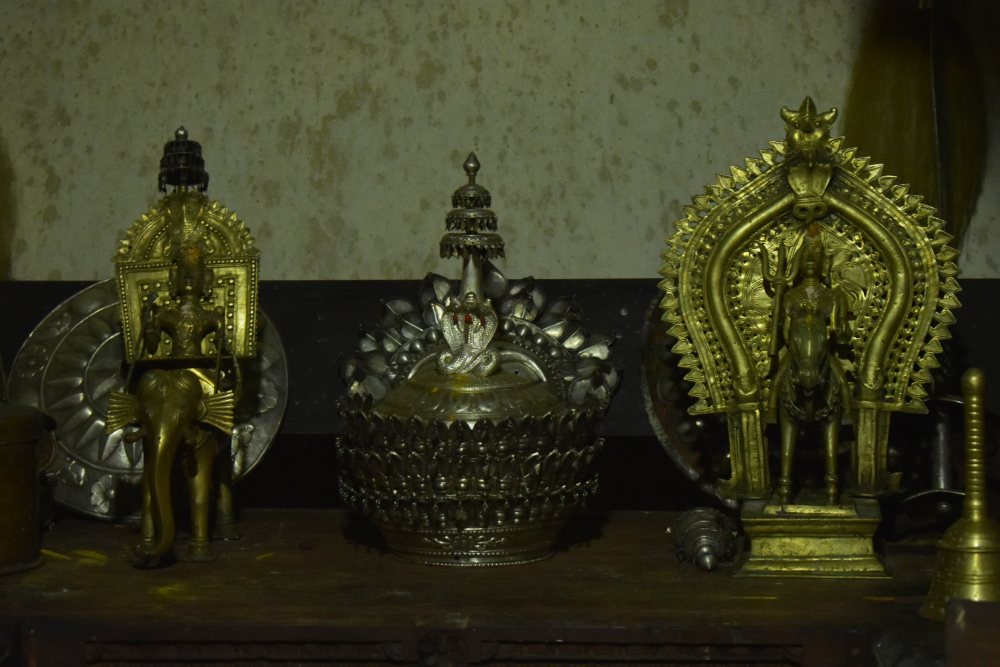
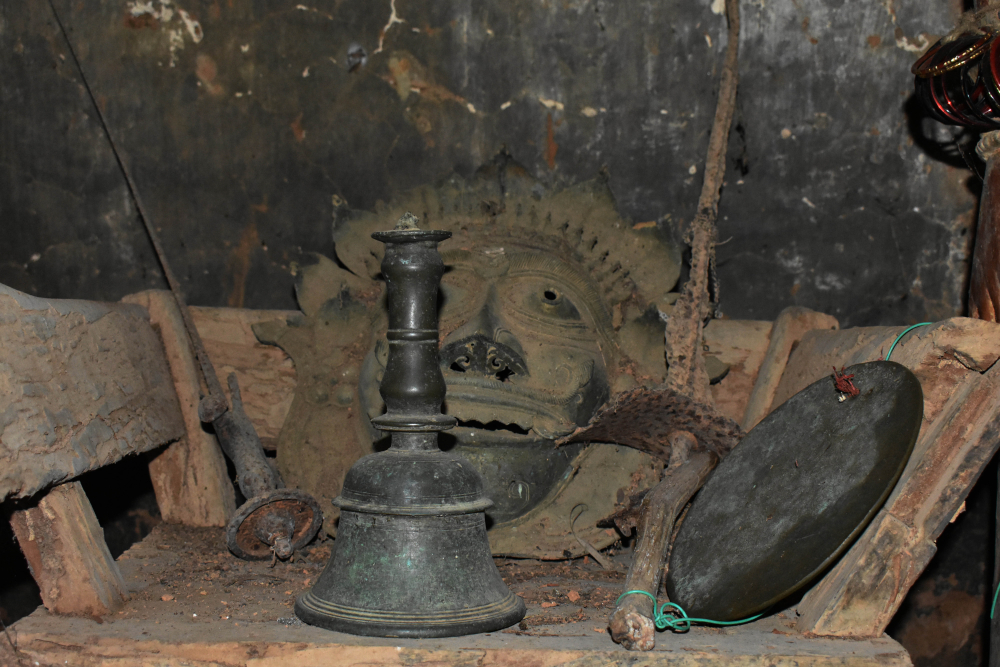
Daivakone generally houses the spirits categorised as rajandaivas (royal guardian spirits), including spirits such as Jumadi, Panjurli and Malarayi; other guardian spirits are housed in garadimane (a religious establishment housing symbolic structures representing the bhoota), which is located away from the guttumane at another place in the village. (Fig. 4)
The rajandaivas housed at guttumanes can be impersonated by a paatri who takes care of the services offered to daivas throughout the year, especially on the auspicious day of sankranti every month. On every sankranti, the resident paatri placed offerings made of rice on banana leaves in front of the daivas in the daivakone, which would later be fed to crow.
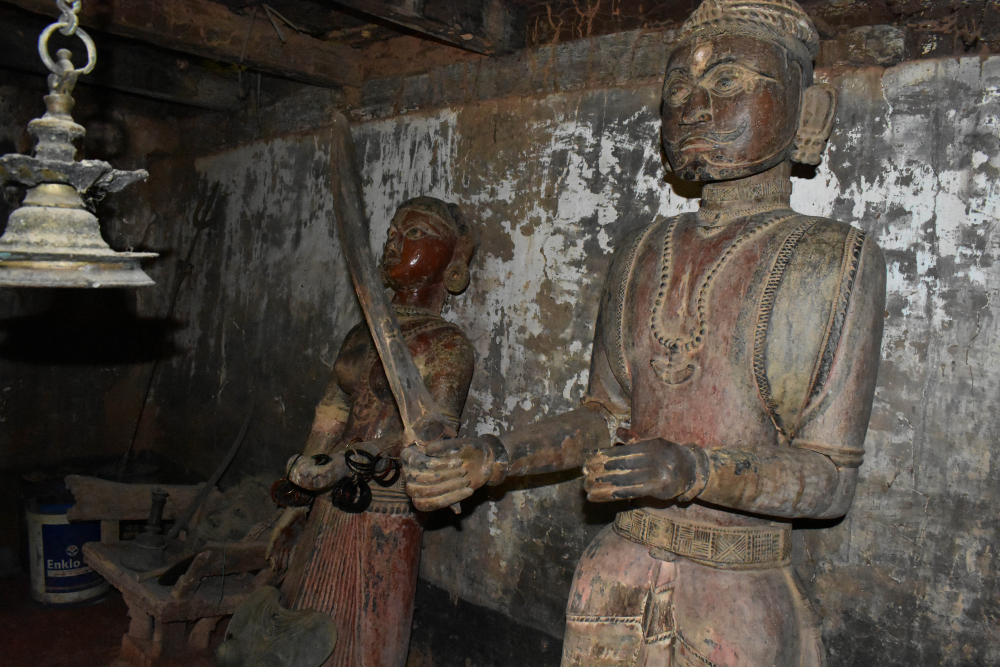
The construction of the daivakone within a guttumane was based on a couple of factors. Firstly, the materials housed in this room were extremely precious and had to be protected. Owing to the infrastructural stronghold, these homes were the only safe place in the entire village back in time. Secondly, the religious importance associated with the guttu owner obliged him to also facilitate financially the annual bhoota kola. Since the guttu family funded and executed the cultural practices such as bhoota kola and feasts for the entire village, it was only natural that the materials relevant to the event were placed at the manor.
The daivakone had to be built in the west side of the house, facing the east, which was dictated by the popular Tulu saying, ‘Paddayi gundad jappuvane baala bhandara’ (the guardian spirits arrive ascending from the western direction). However, within the kone, a guardian spirit named Moolamaisandaya, who is believed to be a vegetarian and the highest in hierarchy, is always placed facing the west. The positioning of the daivas and the directions they face depends on their place in the hierarchy—the most important daivas are placed towards the right end of the room, the female guardian spirits are always placed on the right side of the male ones to denote a brother-sister relationship and on the left to show a marital relationship. This setup can be noticed in every guttumane even today in Tulunadu.
During bhoota kola, the first rituals are performed at the guttumane with the worship of all the belongings of the daivakone in the presence of the paatris and other prominent villagers. The daivas and the various materials are then carried to the garadimane or an empty agricultural field. The paatri generally wears all the materials such as crowns, swords and shields on his body during the ceremony. (Fig. 5) After the service, the materials are brought back equally ceremoniously to the guttumane. Sometimes, the paatri comes back dressed in the same attire to perform a few rituals before dismantling the attire. (Fig. 6)
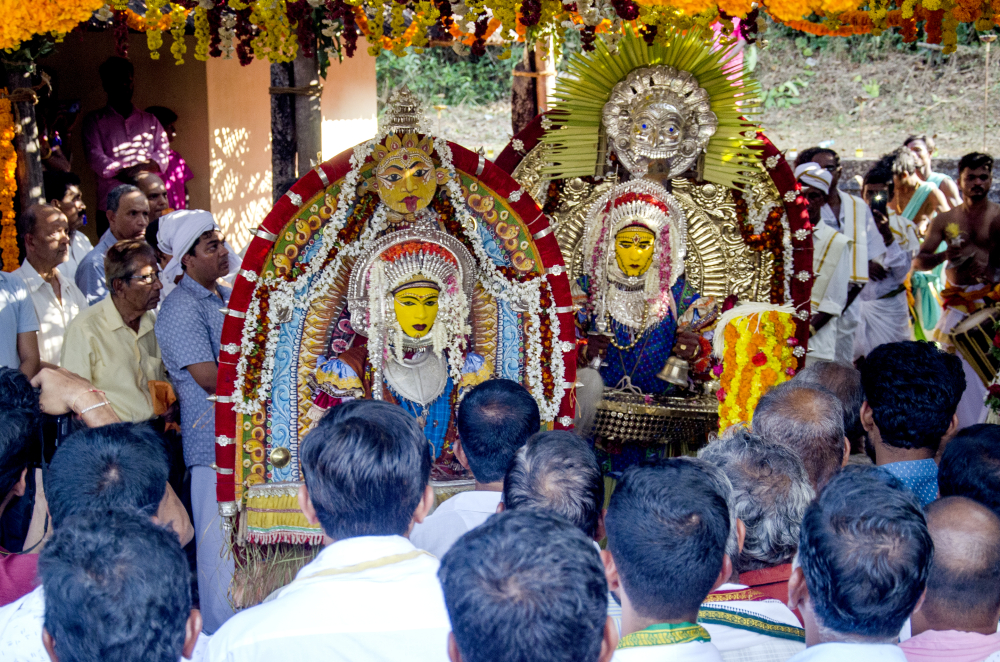
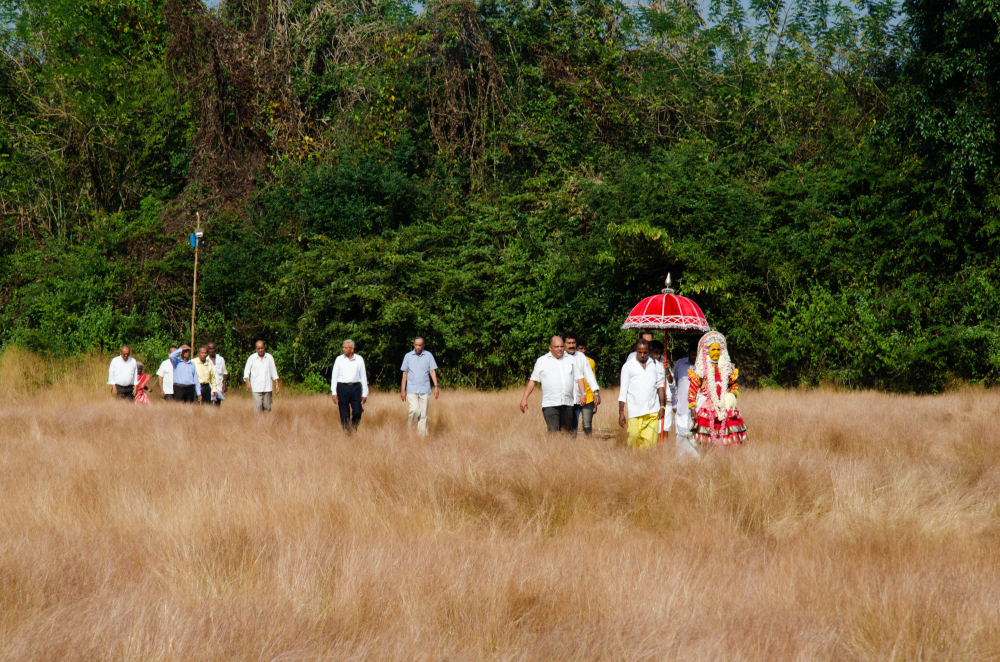
Bhoota kola is a very serious annual custom in Tulunadu. Though Tuluvas today believe in gods as well as daivas, the inclination in devotion towards the daivas is quite evident. The guttu owners of that village still perform the bhoota kola rituals and fund it. With the decline of administrative power, land ownership and royal validation, the religious importance granted by bhoota kola is a massive sustaining factor for these guttumanes. Once a home in Tulunadu has a daivakone built in it, it is never left vacant or renovated without consent of the daivas; this fear and respect played a major role in conserving the guttumane heritage of Tulunadu.
